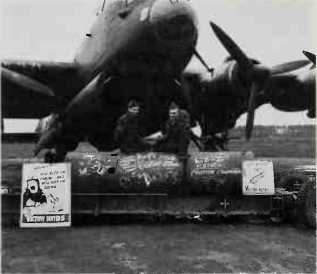Bofors gun. Widely used, reliable World War II 40mm light antiaircraft gun.
Bogan, Vice Adm Gerald Francis
(b. l894). US. US Navy fleet carrier commander; led carrier support groups in the New Guinea and Marianas campaigns and in the flnal attacks on Japan. Particularly notable for his handling of Task Group 38.2 at Leyte Gulf, October 1944.
Bogdanov, Marshal Semyon
(1894-1960). Russian. A specialist commander of armoured units, Bogdanov distinguished himself during the battles of Moscow, Stalingrad and Kursk. After recovering from serious wounds, he led the Second Guards Tank Army during the advance on Berlin and participated in the city’s capture.
Bohusz Szyszko, Maj Gen Z (xxxx-xxxx). Polish. Commander II Polish Corps during the flnal Allied offensive in Italy in April 1945; entered Bologna before the Americans on April 21.
Bologna, Allied autumn offensives towards (October-December 1944). After breaching the Gothic Line, but failing to break out of the Northern Apennines into the Po Valley in September, Alexander renewed the offensive with both Fifth and Eighth Armies (Clark and McCreery), aiming to take Bologna and Ravenna before winter. Hitler, having refused to authorize the withdrawal to the Alps, demanded a rigorous defence of every Apennine ridge and Romagna river.
In the Fifth Army’s offensive, II US and XIII British Corps fought their way forward in the Apennines throughout October in deteriorating weather conditions against a determined defence by I Parachute Corps (Schlemm) and LI Mountain Corps (Feuerstein). Strategic bombers were used on October 12 to blast a way through the German defences covering Bologna, but Schlemm’s Corps did not give way. Clark halted his offensive on October 26 only 12 miles (19km) short of Bologna, intending to reopen it when Eighth Army’s operations in the Romagna had drawn off some of the German mobile divisions concentrated against him, and provided there was enough flne weather for the strategic bombers to help breach Bologna’s defences.
In the Eighth Army’s offensive, McCreery adopted the policy of using II Polish Corps (Anders) to turn successive German defence lines based on the Romagna rivers, while V Corps (Keightley) and I Canadian Corps (Burns) attacked frontally. In a series of grinding attritional battles, successive river lines were breached until Eighth Army closed up to the Senio in mid-December when Alexander halted operations for the winter.
Fifth Army’s offensive was not resumed because the weather did not improve, and because the Germans opened a spoiling offensive down the Serchio valley on December 26. WGFJ.
Bologna, fall of (April 21 1945) see
PO RIVER, BATTLE OF THE.

Lancaster bomber publicizes war loan
Bomber Command. Created by the reorganization of the raf in July 1936. This showed the importance which was attached to the prospective strategic air offensive. From 1940 onwards, the headquarters were at High Wycombe. The Aoc-in-c during the war were Sir Edgar Ludlow-Hewitt (until April 1940), Sir Charles Portal (until October 1940), Sir Richard Peirse (until January 1942) and Sir Arthur Harris (1942-45). The principal wartime aircraft were Wellingtons, Whitleys, Hampdens and Blenheims, which were progressively replaced by Stirlings, Hali-faxes, Lancasters (which derived from Manchesters) and Mosquitoes. In 1968 the Command was merged with others to form Strike Command. ANF.
Bombing, types of, to 1945, after which nomenclature changed. Area-, target was a collection of objects as opposed to an individual one or pinpoint, e. g. built-up area of an industrial town. “Baedeker”: British term to describe German attacks on towns of historic interest. Blind: bombs or markers aimed from above cloud or in dark on radar indications. Carpet: American term for area bombing. Dive: bombs aimed by pointing the nose of the aircraft at the target in a steep dive; a speciality of German Stukas. Incendiary: use of Are bombs to exploit the selfdestructive nature of the target. Off-Set: markers deliberately displaced from the target; bombsights then biased so that by aiming at the marker the target would be hit. Done to avoid blowing out of markers by bombing and to deceive enemy into not extinguishing them; a speciality of 5 Group, Bomber Command. Pinpoint: target was a discreet object of relatively small size e. g. individual factory or viaduct. Precision: literally accurate but by derivation opposite of area bombing, i. e. target was an individual object as opposed to a collection of objects. Saturation: object was to swamp ground defences and rescue services. Selective: series of attacks aimed at an associated group of targets e. g. oil plants or aircraft factories which were known as “Target Systems”. Selective bombing could be attempted either by area or precision attack. Shuttle: instead of returning to base the bombers flew on to land beyond the target, e. g. in North Africa or Russia. Strategic: attack on the sources, as opposed to the manifestations, of enemy war effort, e. g. production of war materials or morale of industrial population. Tactical: attack on the manifestations of enemy armed forces, immediate supply lines or ships at sea. Terror: emotive term often used by one belligerent to describe attacks by its enemy or generally by those opposed on principle to bombing. Visual: bombs or markers aimed by sighting the target. ANF.
Bomdi La (India-China War 1962).




 World History
World History









